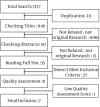Are women with polycystic ovarian syndrome at a high risk of non-alcoholic Fatty liver disease; a meta-analysis
- PMID: 25598791
- PMCID: PMC4286712
- DOI: 10.5812/hepatmon.23235
Are women with polycystic ovarian syndrome at a high risk of non-alcoholic Fatty liver disease; a meta-analysis
Abstract
Context: Insulin resistance is a hallmark of metabolic syndrome (MS). It has been proposed that both polycystic ovarian syndrome (PCOS) and nonalcoholic fatty liver disease (NAFLD) are correlated with Insulin resistance. Therefore, PCOS and NAFLD can be attributed with insulin resistance and therefore MS. The aim of this meta-analysis was to determine whether PCOS patients are at a high risk of NAFLD.
Evidence acquisition: Google scholar, Scopus, ISI Web of Science, Embase, MEDLINE, and some Iranian databases such as scientific information database (SID), IranMedex, and MagIran were searched to identify relevant studies. We included all papers regardless of their language from January 1985 to June 2013. By using data on prevalence of NAFLD in patients with and without PCOS, odds ratio (OR) with 95% confidence intervals (CIs) were calculated in each study. Chi-squared test was used to assess heterogeneity between studies.
Results: We finally included seven eligible studies. According to chi-squared test, there was a significant heterogeneity (73.6%) between studies (P = 0.001). NAFLD prevalence was significantly higher in patients with PCOS compared to healthy control, with an overall OR of 3.93 (95% CI: 2.17, 7.11).There was no significant publication bias based on Begg's and Egger's tests.
Conclusions: According to the results of this meta-analysis, there was a high risk of NAFLD in women with PCOS. We suggest evaluating patients with PCOS regarding NAFLD.
Keywords: Insulin Resistance; Meta-Analysis; Metabolic Syndrome; Non-alcoholic Fatty Liver Disease; Polycystic Ovary Syndrome.
Figures
References
Publication types
LinkOut - more resources
Full Text Sources
Other Literature Sources



